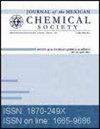红苋菜(Amaranthus cruentus L.)分析液相色谱-质谱分析
IF 0.8
4区 化学
Q3 CHEMISTRY, MULTIDISCIPLINARY
引用次数: 0
摘要
摘要甜菜素是一种天然色素,负责苋菜属的花、苞片、茎和叶的颜色,它们是生物活性化合物。由于其巨大的化学多样性,甜菜碱的测定和自信鉴定仍然是挑战和极大的兴趣,因为它们是有益健康的天然着色剂。采用高效液相色谱-串联质谱联用技术,确定了红苋菜(Amaranthus cruentus L.)中甜菜素的种类。共检出甜菜青素30种,甜菜青素13种。母体离子及其碎片的质量测量误差小于百万分之五(ppm),达到了鉴定化合物的推荐标准。本文确定了红苋菜(A. cruentus)中的主要甜菜素,并确定了红苋菜的叶片和花序是甜菜素的主要来源。Resumen。Las betalaínas son pigmentos naturales负责绘制花卉的颜色,brácteas, tallos y hojas del gsamero Amaranthus y tamamsamons compuestos生物活性。Debido a suamplia diversidad química, la identificación y determinación conconsible de betalaínas siguen siendo desafíos y son de gran intersians puesto que son colorantes naturales beneosos para la salud。Por medio de cromatografía de líquidos de alta efficiencia acoplada a espectrometría de masas en tándem se definió el catálogo de betalaínas en " amaranto rojo " (Amaranthus cruentus L.)。总的来说,他们对30个betbetanini和13个betbetanini进行了对比。Las mediciones de Las masas del ion molecular by sus fragmentos conconres res 5 parties por millón (ppm) garantizaron los criteros recommendations para la identificación de compuestos。Este trabajo定义了las principales betalaínas del amaranto rojo (A. cruentus)通过valora las hojas和花序deramaranto rojo comente de pigmentos betalaínicos。本文章由计算机程序翻译,如有差异,请以英文原文为准。
Analysis of Red Amaranth (Amaranthus cruentus L.) Betalains by LC-MS
Abstract. Betalains are natural pigments responsible for the colour of flowers, bracts, stems, and leaves of genus Amaranthus, and they are bioactive compounds. Due to their great chemical diversity, the determination and confident identification of betalains are still challenges and of great interest as they are natural colourants for health benefit. By high-performance liquid chromatography (LC) coupled to tandem mass spectrometry (MS), the catalog of betalains in red amaranth (Amaranthus cruentus L.) was defined. In total, 30 betacyanins and 13 betaxanthins were found. Mass measurements for the parent ion and for its fragments with errors of less than 5 parts per million (ppm) achieved the recommended criteria for identification of compounds. This work defines the main betalains in red amaranth (A. cruentus) and valorizes the leaves and inflorescence of red amaranth as betalain pigments sources.
Resumen. Las betalaínas son pigmentos naturales responsables del color en las flores, brácteas, tallos y hojas del género Amaranthus y también son compuestos bioactivos. Debido a su amplia diversidad química, la identificación y determinación confiable de betalaínas siguen siendo desafíos y son de gran interés puesto que son colorantes naturales beneficiosos para la salud. Por medio de cromatografía de líquidos de alta eficiencia acoplada a espectrometría de masas en tándem se definió el catálogo de betalaínas en “amaranto rojo” (Amaranthus cruentus L.). En total se encontraron 30 betacianinas y 13 betaxantinas. Las mediciones de las masas del ion molecular y sus fragmentos con errores menores a 5 partes por millón (ppm) garantizaron los criterios recomendados para la identificación de compuestos. Este trabajo define las principales betalaínas del amaranto rojo (A. cruentus) y valora las hojas e inflorescencias del amaranto rojo como fuente de pigmentos betalaínicos.
求助全文
通过发布文献求助,成功后即可免费获取论文全文。
去求助
来源期刊
CiteScore
2.00
自引率
0.00%
发文量
0
审稿时长
6-12 weeks
期刊介绍:
The Journal of the Mexican Chemical Society (J. Mex. Chem. Soc.) is a scientific, blind, peer reviewed, and open access, free of charge publication that covers all areas of chemistry and its sub-disciplines (i.e. medicinal chemistry, natural products, electrochemistry, material science, computational chemistry, organic chemistry, bionirganic chemistry, etc). It is devoted to facilitating the worldwide advancement of our understanding of chemistry. It will primarily publish original contributions of research in all branches of the theory and practice of chemistry in its broadest context as well as critical reviews in active areas of chemical research where the author has published significant contribution. The J. Mex. Chem. Soc. is a quarterly publication which language of submission and publication is English. To be suitable for publication in J. Mex. Chem. Soc., manuscripts must describe novel aspects of chemistry, high quality of results and discussion an excellent bibliographic support, and contribute to the development of the field. Routine or incremental work are not suitable for publication in J. Mex. Chem. Soc. Authors are encouraged to send contributions in electronic form. Our online submission system guides you stepwise through the process of entering your article details and uploading your files.

 求助内容:
求助内容: 应助结果提醒方式:
应助结果提醒方式:


